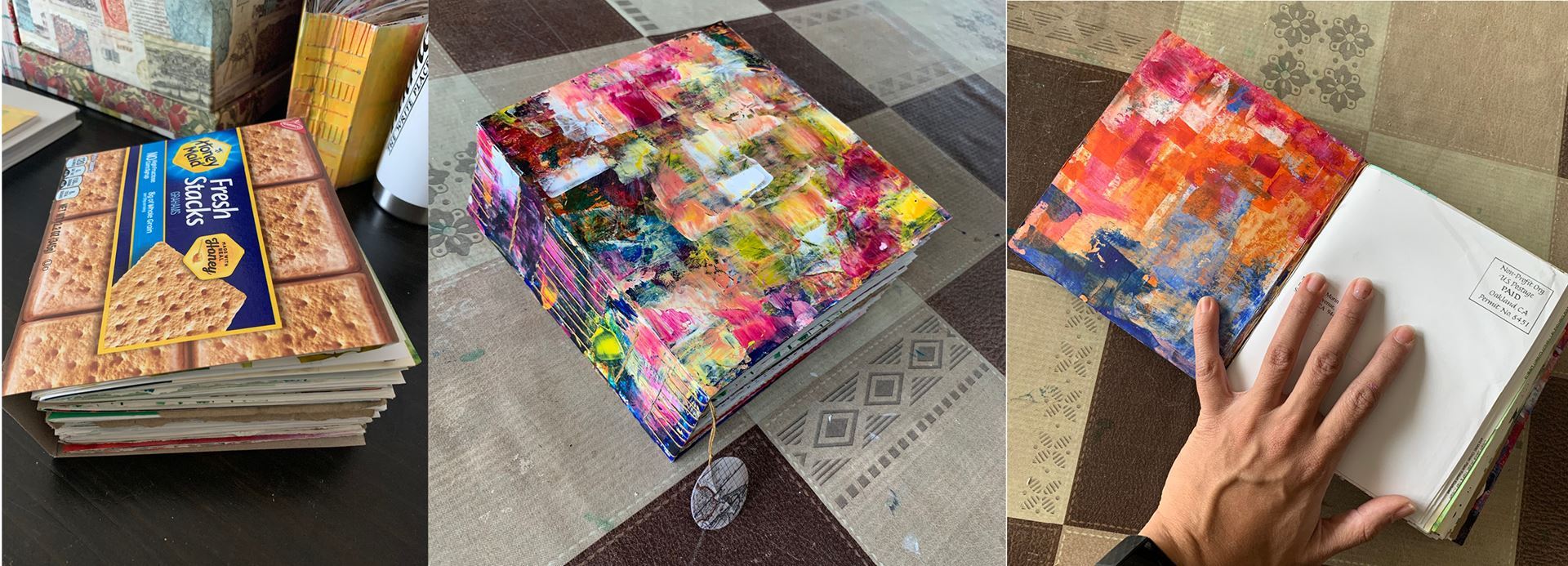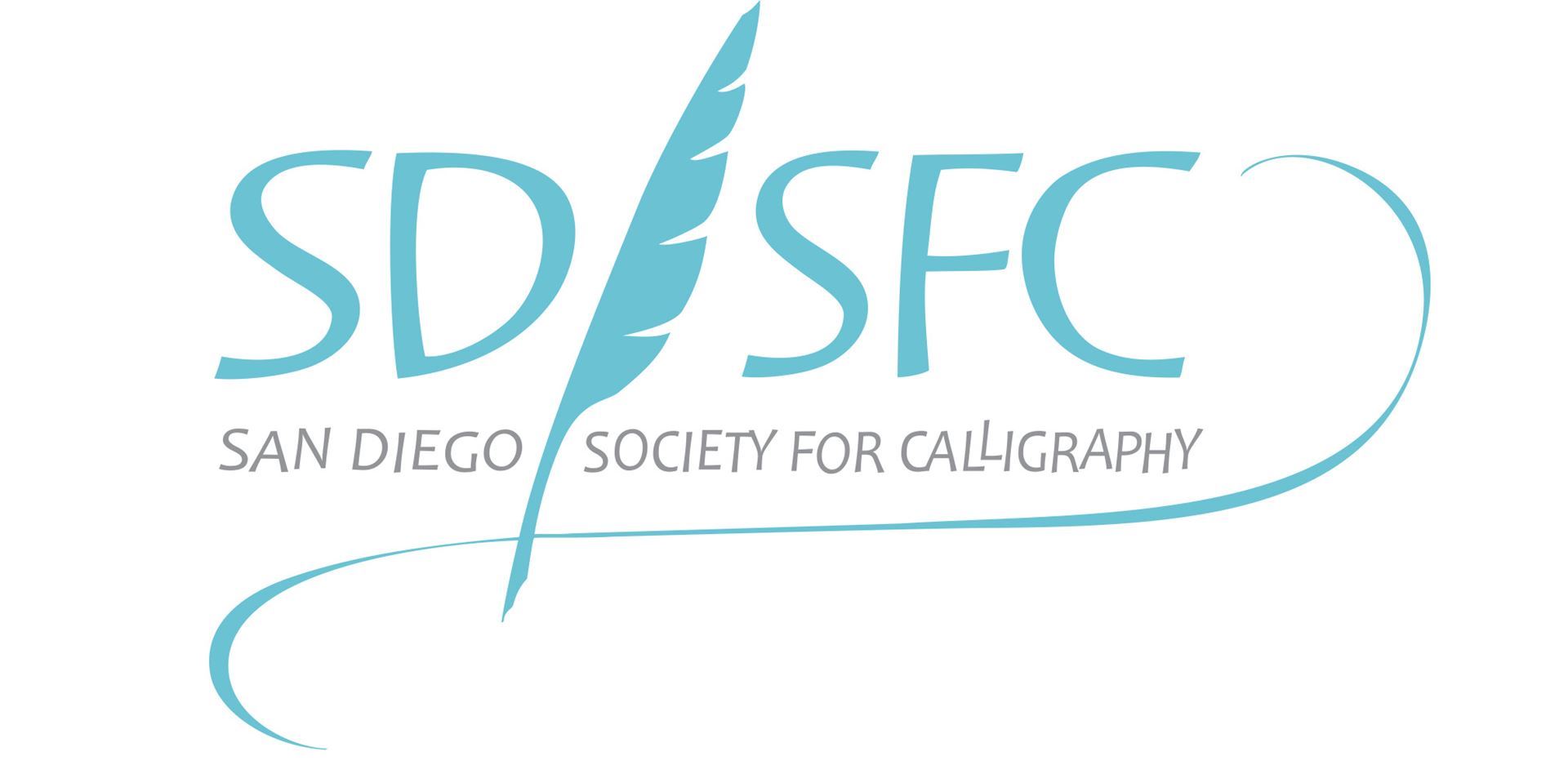Presenter: Michelle Morin
 Sponsor: San Diego Chapter
Sponsor: San Diego Chapter 
A hand-bookbinding tutorial using found and chosen materials to make custom, sewn-spine journals
ABOUT THE PROGRAM: In this class, we will use found materials (cracker boxes, recycled junk mail, used wall calendars, leftover or offcut art papers, etc.) to create and hand-bind satisfyingly chubby “junk journals” using long stitch and chain stitch bookbinding techniques. We’ll learn how to make a custom-fit piercing guide and how to make a piercing cradle from recycled materials. You’ll also learn to see potential recyclable journal material all around you! As time permits, we’ll share ideas for decorating and using your jumbo junk journals and show you a smaller, pamphlet-stitched variation on the “jumbo” journal.
Making a journal yourself, from found or recycled materials, is incredibly freeing… and addictive. These books can be used for so many types of creative expression! I use mine as mixed-media art journals, sketchbooks, storehouses for ideas or images I want to explore later, and as a place to stick collage art… the sky’s the limit.
ABOUT "MIMO": Michelle Morin ("Mi Mo") enjoys learning and creating across several visual arts and calligraphic traditions, including mixed-media, watercolor, hand bookbinding, calligraphy and lettering. Mi Mo teaches Copperplate-based Modern Calligraphy and has hosted calligraphy study groups and creative exploration meetups in-person and online. She is also a collector of fountain pens, hoarder of art supplies, avid journal-keeper and journal-maker, Programming Chair for Pacific Scribes, lawyer, and member of several calligraphy guilds. You can find Mi Mo on Instagram @michelle.l.mo and @calligra_mi.
SUPPLY LIST:
Bookbinding supplies to have handy:
- Strong thread or string with which to bind your book. You could use embroidery thread or other thin string if you already have it. Choose waxed or unwaxed linen thread designed for bookbinding, if you are buying new.
- Beeswax - to wax your chosen thread (unless you’ve purchased pre-waxed thread).
- Curved bookbinding (or upholstery) needle. If you only have a straight needle you can use it, but it will be harder to maneuver. Whatever you use, your string or thread has to fit!
- An awl or improvised tool with which to poke holes into your papers and cover.
- Ruler, pencil
- Piece of tracing paper, layout bond paper, or other scrap paper – cut this to the same size as the spine of your book; it will become a piercing guide.
- Cutting tools for paper and cardboard: at least an X-Acto knife or Olfa knife; optionally, also scissors, paper trimmer, etc.
- A few paper clips.
- Paper folding tool (optional… for example a bone folder, or the back of a spoon, or your fingernail).
- A few binder clips (optional).
- A piercing cradle (optional; it makes poking holes in all the pages easier). You can make one from the flap and one side of a cardboard shipping box, like an Amazon shipping box, or from a piece of foam board, and some masking tape (see tutorial at the end of this supply list).
Material for the cover and pages of the junk journal
(a big part of the fun is gathering the materials for the cover and the pages!)
Cardboard box, such as a graham cracker box, frozen pizza box, or Ritz cracker box, cut and prepared as follows:
- Open the glued edges of the box until it is one flat piece of cardboard which will become a one-piece (wraparound) front cover, spine, and back cover for your junk journal. The narrowest side of the box becomes the spine of the book.
- Keep the front cover, spine, and back cover attached to each other as one piece. Trim off the top and bottom box flaps that stick out, so that the whole piece is just a long rectangle.
- Optional: decorate the outside cover, for example by painting with acrylic paints or covering with collage paper or decorative paper – we won’t have time to let any paint dry during class. Your spine stitches will show on the outside of the spine.
A collection of papers folded into signatures (see image). The height and width of each folded signature should be the same as or smaller than the height of your book cover. Recto and verso (right and left sides of the folded signature) need not be symmetrical. For example, if a page is really long you could fold one side in rather than trimming it. Or if it is too short you can have one side be just a flap.
Examples of papers to collect for book pages
- Old calligraphy practice sheets, best if 9x12 inches or 11x17 inches (or bigger).
- The front covers from emptied pads of paper, best if 9x12 inches or bigger.
- Pieces cut from brown packing paper or brown paper bags.
- Scrap paper or decorative paper you didn’t like or didn’t finish on other projects, such as offcuts from big sheets of watercolor or Arches text wove or cover papers from other bookbinding projects.
- Your art that you don’t mind cutting/binding into a book (paste paper, sketch paper, watercolor paper, mixed-media paper, etc.)
- Recycle any pieces of leftover cardstock, scrapbook paper, or cardboard that are big enough to make a signature. Freshly meal boxes, for example.
- Old magazine pages. For example, take the staples out of a USPS stamp catalog and voila! You have pre-folded signatures made from sturdy magazine paper.
- Junk mail, especially if you get newsletter-formatted junk mail (bigger pages)
- Recycled manila or other large envelopes in which you’ve received mail, like the envelope from calligraphy guild mailings.
- Old wall calendars, old (used) wrapping paper
**Don’t worry if the scrap or recycled paper is very thin: you can put two or more sheets back-to-back and later, after the book is finished, you can glue them together.
**Don’t worry if all your pages are not big enough. It’s OK for some pages to be smaller than others.
A handout will be sent in advance, with instructions/suggestions for preparing your pages and cover.